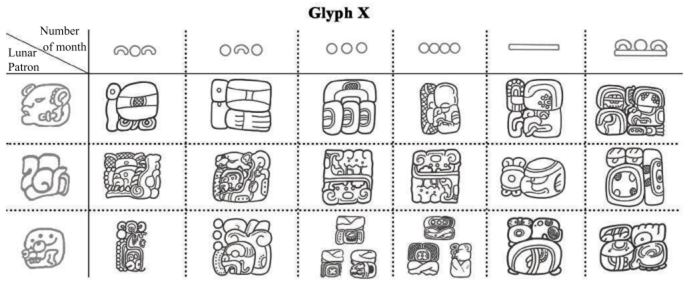
26EMC-HB.pdfp14 & 27EMC-HB.pdfp14
· Glyph-X forms one of the standard components of the SS.
· It is now clear that there are (at least) 18 distinct forms of Glyph-B and that they can be very different from one another (i.e. have very different readings).
o There is a correlation between the form of Glyph-X and the combination of the coefficient and god-head of Glyph-C.
o As there are three god-heads and each god-head has a coefficient from 1 to 6, there are 18 distinct combinations.
o There are hence (at least) 18 distinct forms of Glyph-X (with perhaps some sub-variants within each combination).
o This was first discussed in Rohark-DSdM (1996).
o Subsequent attempts at analysing Glyph-X came to other conclusions but the idea of 18 distinct forms correlating with the 3 god-heads of Glyph-C x the 6 coefficients of each god-head was worked on by Sergei Vepretskii, who presented his results at the 21st Sergeev Reading, in Moscow, in 2019.
§ Vepretskii-GX is a recording of this presentation.
§ This used to be publicly accessible on YouTube, but unfortunately now has restricted access.
It seems to me that Vepretskii independently discovered/concluded this, but he cites Rohark’s paper in his presentation.
o This correlation is now quite well accepted, and can be found in 26EMC-HB.pdfp14 and 27EMC-HB.pdfp14. This correlation is shown in the example above.
§ The 3 god-heads are shown vertically, in 3 rows: TMG/IXIIM, JGU/CHUWAJ, DG/KIMI.
§ The 6 coefficients are shown horizontally, in 6 columns: 1, 2, 3, 4, 5, 6.
§ The corresponding Glyph-X is then shown in the table cell which is the intersection of the respective row and column.
There are definitely instances of Glyph-C (plus coefficient) and Glyph-X which don’t fit the above correlation. However they are relatively few in number. This is no different from the occasional discrepancies which appear, between the “theoretical model” (as worked out by epigraphers) and what is seen in reality, in the inscriptions. Such discrepancies could be:
§ Between the HAAB patron in the ISIG and the HAAB month.
§ In Glyph-G’s not matching the LC.
§ In CR’s not matching LC’s.
§ In CRn+1 not matching CRn + DNn.
None of these discrepancies detract from the soundness of the theoretical model as analysed by epigraphers. Instead, they can be taken as mistakes in the calendrical calculation at the time of carving, mistakes made by the carver, or mistakes made by the artist in drawing the inscription (e.g. where the glyphs might be eroded). Furthermore, I think the possibility cannot be excluded that there were small regionally-based differences in the correlation. This could be an explanation for some of the (few) discrepancies.
· More details about each of the 18 forms of Glyph-X can be found elsewhere. See the individual forms for more information.
· The relationship between Glyph-X and Glyph-B:
o ScheleEtAl-TLSiCMI.p6: Glyph-X is optional, but Glyph-B never occurs without the presence of Glyph-X.
o Grube-FoGX.p11.para2: It has long been established that Glyph X in the Lunar Series is followed by Glyph B (Figure 19). Glyph B is only present when Glyph X is present. There are no cases of the use of Glyph B without a preceding Glyph X. In the early Classic period, such as in the early Lunar Series from Tikal and Uaxactun, there are inscriptions with Glyph X, but without Glyph B. The first examples of Glyph B appear at about 9.8.0.0.0 (Brussels Stela, Mayer 1978, Cat. No. 1) and 9.8.10.6.16 (Piedras Negras, Stela 25).
o Sim: the possible combinations are:
§ …, E, D, C, A, or
§ …, E, D, C, X, A, or
§ …, E, D, C, X, B, A
· Summary:
o There are in theory at least 18 different forms of Glyph-X, each representing the name of a specific combination of a coefficient from 1 to 6 and one of 3 god-heads (6 x 3 = 18).
o Glyph-B is optionally present when Glyph-X is present, but can be absent when Glyph-X is present. However, if Glyph-B is present, then Glyph-X is always also present. This is because giving the name (= Glyph-X) doesn’t require also stating that that’s the name (= Glyph-B), whereas stating “(this is) his youth(ful) name” (= Glyph-B) without giving the name (= Glyph-X) wouldn’t make any sense.